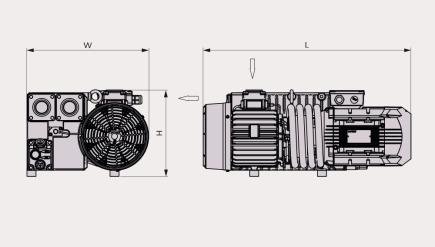5 Reasons You Vacuum Pump Isn't Working
In certain specialized industries, the use of a vacuum pump is essential. It is one kind of equipment primarily used to create a vacuum within a closed container. On a more specific note, it eliminates the air from a closed system by gradually reducing the air density in a restricted space, thereby creating a vacuum.

There’s a wide range of vacuum pumps available in the market. Regardless of the types, the primary function of these pumps is nothing but removing air, vapor, or gases from a closed device. This is strictly required for successful business operations in some industries.
No matter how much you maintain it, your vacuum pump has all sorts of issues surfacing every now and then. Knowledge is power when it comes to understanding the reasons that your vacuum pump isn’t working. Keep on reading to find out.
1. System leak
A vacuum leak is said to be the most common issue with a pump system. This can happen almost anywhere in the system, but you should start by checking couplings and other high stress areas. Be aware of punctures as well as cracks in these areas. When this occurs, the leak will impact the pressure in the vacuum. That said, the first thing to do is to locate the leak. As soon as you find the leak, go ahead and immediately fix the area.
2. Oil
Oil plays a crucial role in the overall function and maintenance of your vacuum pump. But the chances are that your oil may have possible contamination, or you may be using the wrong type and amount of oil for your vacuum pump. It’s essential to check the machine’s oil regularly to ensure it’s clean and properly filled. Make sure you’re using the correct type and filling in the right amount of oil.
3. Foreline traps
Foreline traps are placed between a high-vacuum pump and a backing pump. These traps act as a one way check valve, ensuring that oil does not backflow into the vacuum pump from the backing pump. That said, soiled or blocked foreline traps can significantly impact the vacuum pump pressure. That’s why it’s vital to clean the foreline traps regularly.
4. Open Gas Ballast Valves
Opening the Gas ballast valves will help to exhaust any vapors of the contaminated oil that may be building up in the system. Opening these valves release steam condensation and help to avoid oil pollution and inefficiency. Open gas ballast valves also GREATLY affect pump pressure. You should only open these valves after eliminating the earlier mentioned causes.
5. Clogged Inlet
Often, Vacuum Pump Systems use filters before the inlet to prevent unwanted and harmful debris from entering the system. If the filter becomes dirty and accumulates debris, it will eventually clog. As a result, you can expect affected efficiency and low vacuum levels. That said, what better way to proceed with that to get a screen replacement? That will solve the issue.

If your vacuum pump is not working at its full potential, you are losing efficiency. Keeping your Vacuum Pump and the system as a whole up to date on preventative maintenance will help to prevent many of these and future issues. Regularly preforming these tasks will also lower your likelihood of massive failures.
By understanding the five problems outlined above, you’ll be able to figure out the issue and eventually repair your pump. If not, you can seek the expertise of professionals who can find the source and fix the problem right away.
If you are looking for vacuum pump oil to keep your pump in good working condition, get in touch with us today! We’re happy to help.
Recent Posts
-
The Do's & Don'ts of Vacuum Pump Maintenance - Our Guide
Given the high value of vacuum pumps in terms of both their functionality and actual price, it shou …Dec 12th 2019 -
3 Factors To Help You Choose The Right Vacuum Pump Oil
For anyone looking for a quick answer on which vacuum pump lubricant to use, adhere to this rule: f …Dec 12th 2019 -
5 Reasons You Vacuum Pump Isn't Working
In certain specialized industries, the use of a vacuum pump is essential. It is one kind of equipme …Dec 5th 2019
